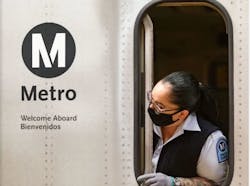L.A. Metro’s Recovery Task Force releases early recommendations to improve mobility in wake of pandemic
The Los Angeles County Metropolitan Transportation Authority’s (Metro) Recovery Task Force, which was formed this spring to develop a plan on how to best serve the public moving forward from the ongoing pandemic, has released a report that includes a dozen early action recommendations.
L.A. Metro says the agency has also been profoundly affected, with employees falling ill, ridership plunging, bus and rail service reduced and finances eroded.
However, the agency says it has also seen byproducts of the safer-at-home orders that have shown progress on some of the region’s most intractable problems. Specifically, there has been less traffic congestion, improved air quality and safer conditions for walkers and cyclists.
The task force’s mission is to help L.A. Metro respond to and recover from the pandemic while also finding ways to smartly preserve these gains – and to help guide L.A. Metro on how to truly best serve those who need it the most. A final comprehensive report will eventually be issued by the task force.
Decisions on whether and how to implement recommendations will be made by a combination of the board of directors, L.A. Metro’s senior leadership team and responsible departments. The task force will track decisions and steps taken on these recommended early action items and will include updates in future progress reports.
Here are the Task Force’s 12 Early Action Recommendations:
- Survey Metro customers on their transportation needs and experiences. The idea is to get a handle on what ridership will look like in the coming months, figure out what customers want and best understand what would make customers feel safe using our services now and in the future.
- Authorize cities that received 2020 Open Street Grants – i.e. for events such as CicLAvia – to use that money for projects to slow traffic and/or expand walking and biking opportunities on local streets. The L.A. Metro Board approved this in late May.
- Test and implement new cleaning practices to help prevent the spread of the coronavirus and other germs on the transit system. L.A. Metro is currently relying heavily on disinfectants, but the agency will be looking at the use of ultraviolet light as well as cleaning frequencies.
- Find ways to provide face masks to riders. The agency is requiring face coverings to ride. As long as the requirement is in effect, L.A. Metro wants to help riders access masks to avoid enforcement becoming an issue.
- Partner with local cities to accelerate projects that speed up buses – for example, bus lanes or projects that help buses get quickly through intersections. The goal is to make transit more appealing and useful in the future so people don’t feel they have to drive everywhere.
- Matching service levels with demand. Over the past few weeks, the agency has been running about 70 percent of pre-pandemic service levels for about 30 percent of pre-pandemic ridership. The plan is to restore bus and rail service in stages and keep rear door boarding on buses to improve service, allow for physical distancing and – beyond the pandemic – help reduce overcrowding.
- Begin engaging major employers to allow more telecommuting or to stagger work hours to reduce traffic. This includes modifying L.A. Metro’s telecommuting policy to set a good example.
- Put a contactless payment system in place as part of the Transit app – the agency’s official app. This is a good way to reduce touchpoints and make transit more convenient to use.
- Re-imagine projects. It will be difficult for L.A. Metro to recover all the costs of the pandemic and funding – which is heavily dependent on sales tax revenues – will likely be down for quite some time. The task force thinks this is a good time to look at the many projects in the planning phase at L.A. Metro and think about how they can cumulatively deliver the most positive impact to the region.
- Study options to improve the L.A. Metro Bike Share program – specifically to increase the number of locations.
- Expand social services to help find housing for homeless who use the L.A. Metro system.
- Test new ways to help people get around – for example, through on-demand vehicles that provide rides in particular communities or to and from transit stations.
